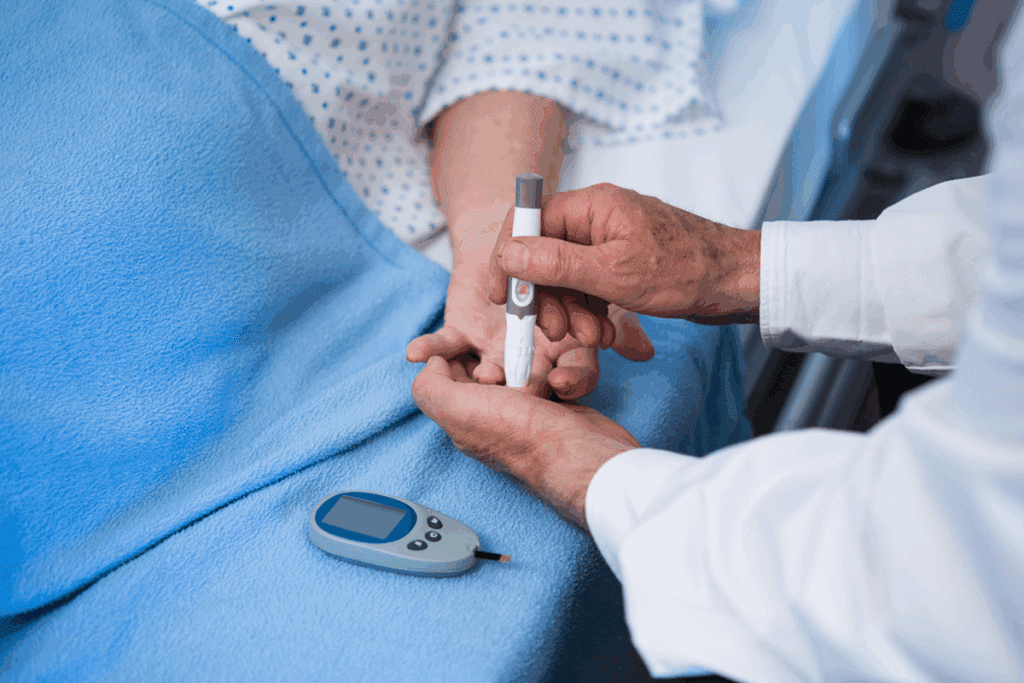
Knowing normal hemoglobin infant levels is crucial for maintaining the health of newborns and young children. Hemoglobin is a protein in red blood cells that carries oxygen throughout the body. At birth, normal hemoglobin infant levels range between 14 to 24 g/dL. By age 1, these levels typically drop to 9.5 to 14 g/dL.
As children grow, their hemoglobin levels gradually increase. Monitoring these levels helps detect potential health problems early. This article explores normal hemoglobin infant ranges and also covers essential iron facts that affect hemoglobin production.

Hemoglobin is key in pediatrics because it helps oxygen reach growing tissues and organs. It’s a vital part of red blood cells, carrying oxygen from the lungs to the body’s tissues.
Hemoglobin plays a big role in oxygen transport in kids. It helps their bodies grow and work properly. Doctors watch hemoglobin levels in kids because they can show health problems like anemia.
Oxygen transport is how hemoglobin picks up oxygen in the lungs and sends it to tissues. This is essential for keeping tissues and organs healthy and working well.
In kids, normal hemoglobin levels are between 9.5 to 15.5 g/dL. These levels change as kids grow, getting closer to adult levels by adolescence. Knowing these ranges helps spot problems with hemoglobin in children.
Pediatric hemoglobin values are different from adults because kids are always growing. Keeping an eye on these values helps find and treat issues early.
Normal hemoglobin levels in children are a key indicator of their overall health. Healthcare providers use this knowledge to improve care for kids.

It’s important to know about hemoglobin levels in babies from birth to 12 months. These levels change a lot in the first year. This is because of many changes in the body.
Babies have a higher hemoglobin range at birth, between 14 and 24 g/dL. This is needed to carry enough oxygen. It’s because they are moving from being in the womb to being outside.
Having the right amount of hemoglobin at birth is key to getting enough oxygen to their bodies. As babies grow, their hemoglobin levels go down.
From 3 to 6 months, babies’ hemoglobin levels start to go down. This shows they are moving towards making more adult-like hemoglobin.
By 6 to 12 months, babies’ hemoglobin levels usually range from 9.5 to 14 g/dL. This range is important for their fast growth and development.
The table below shows the normal hemoglobin ranges for babies from birth to 12 months:
| Age Range | Normal Hemoglobin Range (g/dL) |
| Newborn (0-1 month) | 14-24 |
| 3-6 months | 9.5-13.5 |
| 6-12 months | 9.5-14 |
It’s very important to watch these levels closely. This helps find any problems with hemoglobin in babies early on.
The first year of life sees a natural drop in hemoglobin levels. This is a normal part of an infant’s development. It happens as they switch from using fetal hemoglobin to adult hemoglobin.
Fetal hemoglobin carries oxygen for the fetus and newborn until about 6 months old. After birth, adult hemoglobin starts to take over. This change helps the infant adjust to life outside the womb.
Key aspects of this transition include:
“Physiologic anemia of infancy” is a normal drop in hemoglobin levels in infants. It happens between 2-3 months of age. It’s seen as a normal adaptation, not a disease.
The main reasons for this phenomenon are:
While some hemoglobin drop is normal in infancy, too much or symptoms like pallor or fatigue might be a sign of a problem.
| Age | Normal Hemoglobin Range (g/dL) |
| 1-2 months | 9.5-13.5 |
| 2-6 months | 9.5-12.5 |
| 6-12 months | 9.5-14.0 |
Knowing these ranges helps tell if a hemoglobin drop is normal or not.
Hemoglobin levels in toddlers and preschoolers show how well they’re doing. As kids grow, their hemoglobin changes. It’s key for parents and doctors to watch these levels to keep them in the right range.
For kids 1-2 years old, normal hemoglobin is between 10.5 to 13.5 g/dL. It’s very important to check hemoglobin levels during this time. This helps spot any problems with iron or other nutrients.
At this age, kids start eating solid foods. Their diet is very important for keeping their hemoglobin healthy. Making sure they get enough iron is key.
Kids 3-5 years old should have hemoglobin between 11 to 14 g/dL. Remember, these numbers can change a bit depending on the lab.
As kids get more active, their diet needs to get more complex. A balanced diet with iron, vitamin B12, and other nutrients is vital for healthy hemoglobin.
Several things can affect hemoglobin in young kids. Diet is a big factor, as not enough iron can lower hemoglobin.
Knowing these factors and checking hemoglobin often can help catch and manage problems early.
Normal hemoglobin in kids is between 9.5 to 15.5 g/dL, depending on their age. Regular check-ups and a balanced diet help keep their hemoglobin in the right range.
As kids start school, their hemoglobin levels are key to their health. They grow and get more active in school and sports. It’s vital to check their hemoglobin to make sure they get enough oxygen.
Kids aged 6 to 11 should have hemoglobin between 11.5 and 15.5 g/dL. This range can change a bit depending on the lab. Keeping hemoglobin in this range helps them stay healthy and perform well.
Table: Hemoglobin Ranges for School-Age Children
| Age Group | Normal Hemoglobin Range (g/dL) |
| 6-7 years | 11.5-15.0 |
| 8-11 years | 12.0-15.5 |
How active kids are affects their hemoglobin levels. More active kids might need more hemoglobin. Exercise boosts health but also raises the need for oxygen, which hemoglobin helps meet.
What kids eat is very important for their hemoglobin. They need iron, vitamin B12, and folate to make hemoglobin. Foods like lean meats, beans, and leafy greens are great for a healthy diet.
Adolescence brings big changes in hemoglobin levels, getting closer to adult values. This time is key as it’s when kids grow into adults. Hemoglobin levels show how healthy and developed they are.
As teens go through puberty, differences in hemoglobin levels start to show. Males tend to have higher hemoglobin levels than females. This gap grows more noticeable during this time.
Hormonal changes cause these differences. Testosterone in males boosts red blood cell production. On the other hand, estrogen in females has a smaller effect on red blood cells.
Knowing the normal hemoglobin ranges for teens aged 12-18 is key to checking their health. These ranges change a bit with age and gender.
| Age Group | Male Hemoglobin Range (g/dL) | Female Hemoglobin Range (g/dL) |
| 12-14 Years | 13.0-16.0 | 12.0-15.5 |
| 15-18 Years | 14.0-17.0 | 12.5-16.0 |
By late teens, most teens have hemoglobin levels like adults. Adult hemoglobin levels are usually set by age 18. But some might vary.
Healthcare providers should keep an eye on hemoglobin levels in teens. This helps catch any unusual levels early on.
Infants need enough iron for their fast growth and development. Iron is key to making hemoglobin, a protein in red blood cells. It carries oxygen to the body’s parts. Having enough iron prevents anemia and ensures tissues and organs get enough oxygen.
Iron levels change as infants grow. At birth, they have iron stored for a few months. As they get older, their iron needs change. Here are the normal iron ranges for infants:
| Age | Normal Iron Range (μg/dL) |
| 0-3 months | 100-250 |
| 4-6 months | 50-120 |
| 7-12 months | 60-170 |
Iron stores affect hemoglobin production. When iron is enough, hemoglobin levels are normal. But not enough iron can lower hemoglobin and cause anemia. It’s important to check iron levels in infants to avoid iron deficiency.
Infants with enough iron have healthy hemoglobin, lots of energy, and grow well. Iron deficiency shows as tiredness, weakness, pale skin, and lea reducedppetite. Finding iron deficiency early is key to avoiding health problems later.
Signs of good iron status include:
Signs of bad iron status include:
Iron is key to making hemoglobin in kids. It helps prevent deficiency and keeps them healthy. Iron is a big part of red blood cells, which carry oxygen.
Iron sources change as kids grow. Babies get iron from breast milk early on. Around 4-6 months, they start with iron-fortified cereals.
Toddlers and bigger kids eat more iron. They should have red meat, poultry, fish, beans, and fortified cereals.
It’s important to match food choices with the child’s age and growth. This ensures they get enough iron.
How well kids absorb iron depends on several things. The type of iron and other nutrients matter. Heme iron from animal products is better absorbed than non-heme iron from plants.
Vitamin C helps kids absorb non-heme iron better. But tea and coffee can make it harder.
Some kids might need iron supplements. This is true for those who don’t get enough from food or are at risk of deficiency. Doctors decide if supplements are needed based on tests and checks.
Doctors tell parents how much and for how long to give iron supplements. Too much can harm kids.
Testing a child’s hemoglobin is key to diagnosing and treating hemoglobin-related disorders. It’s important to measure hemoglobin levels accurately. This helps identify conditions that could affect a child’s health and growth.
Laboratory tests, like the complete blood count (CBC), help measure hemoglobin levels. The CBC checks different parts of the blood, including hemoglobin, hematocrit, and red blood cell indices.
The accuracy of these tests relies on proper sample collection, handling, and analysis. Labs must follow strict quality control to ensure reliable results.
Reference ranges for hemoglobin levels can differ between labs. This is due to different testing methods and equipment. Healthcare providers need to understand these differences when looking at test results.
Several factors contribute to these variations:
Interpreting CBC results in children requires age-specific reference ranges and clinical context. Pediatric healthcare providers need to be skilled in analyzing these results. This helps diagnose and manage hemoglobin-related conditions effectively.
Key components of CBC interpretation include:
Understanding laboratory assessment methods and accurately interpreting test results is vital. Healthcare providers can then ensure the best diagnosis and management of pediatric hemoglobin-related conditions.
Regular screening and risk-based assessment are key in pediatric care. They help healthcare providers spot issues early. This ensures timely action and the best results for kids.
Guidelines suggest screening hemoglobin levels at different ages. The American Academy of Pediatrics recommends:
Screening at these times helps catch problems early. This allows for quick action.
Risk-based assessment looks at factors that might lead to hemoglobin issues. These include:
By looking at these risks, healthcare providers can focus on what each child needs.
If initial screening shows abnormal hemoglobin levels or if there are risk factors, more tests are needed. This might include:
Getting these tests done quickly is vital. It helps diagnose and manage hemoglobin issues effectively, ensuring the best care for children.
Hemoglobin changes in kids can show health problems that need quick action. Many diseases can change hemoglobin levels. It’s key for doctors to know this to help their patients.
Iron deficiency is a big reason for low hemoglobin, but it’s not the only one. Chronic diseases like kidney problems or inflammation can cause anemia. Infections like malaria or tuberculosis can also lower hemoglobin by destroying red blood cells.
Thalassemia is a genetic disorder that affects hemoglobin production. It can cause severe anemia, needing blood transfusions often. Other genetic issues, like sickle cell disease, can also affect hemoglobin and red blood cells.
High hemoglobin levels in kids can come from polycythemia vera, a rare blood disorder. It makes too many red blood cells. Heart or lung diseases can also cause high hemoglobin by making more red blood cells.
Certain kidney diseases can make hemoglobin levels go up because of too much erythropoietin. Knowing why is key to treating these conditions well.
Hemoglobinopathies, like sickle cell disease and thalassemia, change what’s normal for hemoglobin levels. These genetic disorders mess with hemoglobin’s structure or how it’s made. Sickle cell disease, for example, can cause red blood cells to break down too fast.
“The presence of hemoglobinopathies necessitates the use of specific reference ranges to accurately diagnose and manage these conditions.”
Doctors need to know about these conditions and how they affect hemoglobin. They must watch kids closely and plan their care carefully.
Keeping hemoglobin levels right is key to kids’ health. It’s important to watch and keep these levels in check. Parents and doctors can help by knowing about normal hemoglobin and the role of iron.
Guidelines say it’s important to check hemoglobin in kids, more so when they’re growing fast. Babies and teens are more likely to get iron deficiency anemia. This can lower their hemoglobin. Looking at data from places like the University of Calgary’s Iron Deficiency Anemia page can help us understand how to keep hemoglobin levels right.
By keeping an eye on hemoglobin and encouraging healthy eating, we can help kids avoid problems. This way, they can grow and develop well.
Hemoglobin levels in infants change as they grow. At birth, they are between 14-24 g/dL. By 3-6 months, they drop to 9.5-13.5 g/dL. And by 6-12 months, they are 9.5-14 g/dL.
Hemoglobin is a protein in red blood cells. It carries oxygen to all parts of the body. This ensures tissues get the oxygen they need to work properly.
“Physiologic anemia of infancy” is a natural drop in hemoglobin in infants. It happens as they switch from fetal to adult hemoglobin.
Hemoglobin levels in children also change with age. For 1-2 year olds, it’s 10.5-13.5 g/dL. For 3-5 year olds, it’s 11-14 g/dL. And for school-age kids (6-11 years), it’s 11.5-15.5 g/dL.
Iron is key to making hemoglobin. Kids need enough iron to keep their hemoglobin levels healthy.
Iron-rich foods are important for kids. These include red meat, poultry, fish, beans, lentils, and fortified cereals. The right amount of iron varies with age.
How often to check hemoglobin levels depends on the child’s age and risk factors. Regular checks are recommended at certain times.
Several conditions can change hemoglobin levels in kids. These include iron deficiency, anemia, hemoglobinopathies, and other disorders.
Signs of iron deficiency in kids include fatigue, weakness, pale skin, and poor appetite. These are just a few.
More tests are needed if hemoglobin levels are off or if there are signs of other conditions. These could affect hemoglobin levels.
Subscribe to our e-newsletter to stay informed about the latest innovations in the world of health and exclusive offers!